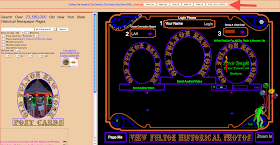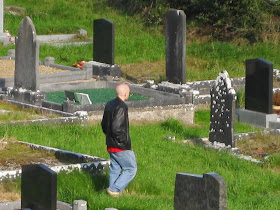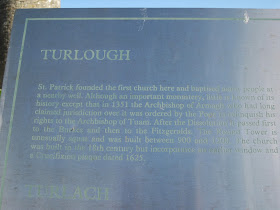One of the most significant online resources for research in New York State is the website
FultonHistory.com. It has dozens of out-of-copyright NYS newspapers, all scanned, OCR-searchable, and available online for free. The site's owner, Thomas Tryniski, has undertaken this entire project by himself, and does not, as far as I'm aware, receive any monetary gain as a result - just the undying love and appreciation of every genealogist who's ever attempted to research in New York State.
(Don't be misled - although the site focuses on New York papers, just in doing test searches for this post, I came across results from newspapers in Massachusetts, Pennsylvania, Canada, and Mexico; it's worth at least a glance, no matter where your research is focused!)
My research wouldn't be the same without Fulton History, but I've heard over and over again - from cousins researching our joint lines as well as from fellow genealogists on list servs, in comment boxes, and elsewhere - that they don't utilize the site because they just can't figure it out, or they don't know how the search function works, or their searches return thousands of results and can't be narrowed down.
Now, any OCR (Optical Character Recognition) searchable database is at the mercy of the quality of the images, and my understanding is that what Fulton History has access to tends to be second- and third-generation library copies of the microfilmed newspapers, so the images - and, as a result, the search function - are not necessarily the highest quality. However, when you know what you're doing, searching Fulton History is actually quite easy, and it's 100% worth it to take the time to learn. It will absolutely revolutionize your research.
As a result, I've put together this tutorial, in hopes that it will convince some people to take another look at Fulton History. (And also so that I have something to link to, rather than typing out directions every time the subject comes up on the Brooklyn list!)
Step 1: The Goldfish
On the first screen, you'll meet the swimming goldfish, the first of several utterly unusual but charming elements of this site. Although the site's title is technically
Old Fulton Post Cards, the vast majority of the content is newspapers, not postcards. Click "Enter" to get to the search page.
Step 2: The FAQ
I'm writing up my tutorial here, but I strongly suggest reading the FAQ. Once you've reached the search page, click on the "FAQ_HELP_INDEX" button at the top right. It's worth it to get an idea of the different search strategies that Tryniski built into the site, not all of which are ones I will cover here.
Step 3: The Index
For our searching purposes, it will be vital to know
which of the newspapers on the site you're interested in searching. The index is not necessarily easy to find, but there is a link to it in the first lines of the FAQ, so it's good to visit while you're already in the FAQ thanks to Step 2.
It's also not particularly user-friendly, so I highly recommend downloading the Excel file to your computer, which is much easier to handle. There is a link to do so at the top right of the page:
Once you're looking at the Excel file, you can use CRTL+F (or COMMAND+F, if you're on a Mac) to search for the titles of newspapers you're interested in, as well as to find out what other papers exist for the areas you're researching. The index includes the county in which each paper was published, so searching for the county of interest is a good way to find out what newspapers might have been published nearby. If I search for "Kings" County (aka Brooklyn), I get a number of results that are actually for Kingston, so I'll search for Brooklyn instead - luckily, all of the references to Kings County are followed by "(Brooklyn)," although that's only the case for boroughs of NYC. I get the following results:
- Brooklyn NY Daily Eagle 1841-1955
- Brooklyn NY Daily Star 1898-1933
- Brooklyn NY Daily Union Argus 1877-1883
- Brooklyn NY Daily Union 1870-1887
- Brooklyn NY Standard Union 1888-1932
- Brooklyn NY Union 1883-1886
- Brooklyn NY Weekly People 1901-1973
You can compile a similar list for any county you're interested in. Be sure to note them exactly as they appear. If you happen to be interested in Brooklyn - or any other borough of NYC - it is also a good idea to look into some New York City (aka Manhattan) papers, too. Even in the pre-1898 days - the days before Brooklyn, Queens, and Staten Island joined New York City - I had Brooklyn families who showed up primarily in New York City papers, as well as Brooklyn families whose newsworthy stories appeared in both Brooklyn and Manhattan papers, oftentimes with different details in each. Get an idea of what newspapers you'll want to search. It won't be exhaustive, and there are search techniques for which you won't need to specify a title, but it's a good place to start.
Step 4: Search using Boolean techniques
The single most useful technique for mining Fulton History website is the Boolean search. Especially if you are looking for an individual with a common name, you need to be able to narrow down your search results so you don't end up with many thousands of results. There are several ways to do this. Regardless of which you plan to use, begin by selecting the "boolean" option from the drop-down menu on the search page.
Now, you have to format your search as a Boolean search. Most basically, this means that words like "and," "or," and "and not" function as operators, rather than search terms. The Boolean search function at Fulton History will search for the terns you enter exactly. Enter your terms; if there is more than one, connect them with one of the above operators. Most often, you'll be using "and," but "or" or "and not" are good to have in your arsenal for when your searches need to be a little more nuanced.
For example, you could search for any of the following terms:
- Michael Mulcahy [returns any page that has the phrase "Michael Mulcahy"]
- Michael AND Mulcahy [returns any page that has both the word "Michael" and the word "Mulcahy," even if they are nowhere near each other]
- Michael OR Mulcahy [returns any page that has either word, including all appearances of "Michael" anywhere in the database]
- Mulcahy AND NOT Michael [returns any page that has the word "Mulcahy" but not "Michael," which is useful if Michael Mulcahy is not your ancestor but a prominent individual who keeps popping up and clogging your results for your other Mulcahys]
Step 4a: Narrow your search
However, any of these could return many hundreds or thousands of results. It's necessary to be able to narrow your search by where your ancestor lived. One nice tip for doing this is using an ancestor's street address as one of your search terms. In the above case, this might mean searching for
Michael Mulcahy AND 85 Luqueer
However, frequently you don't know the ancestor's address, or want to cast a wide-enough net to catch articles that don't include the subject's address. The best way to narrow your search so that you're not finding every Michael Mulcahy in New York State (and beyond) is to search the specific newspapers relevant to the place where your ancestor lived. Return to the list you created in Step 3. In order to search a specific newspaper, you have to use the
exact title of that paper as one of your search terms. (For now, do not include any years in the title.) For example, to search the Brooklyn
Daily Star for Michael Mulcahy, you can use the string
Brooklyn NY Daily Star AND Michael Mulcahy
You can also narrow your search by time frame, though I've found that this really only works well when you are searching by newspaper title as well. Just add YEAR~~YEAR to the end of the newspaper title you are searching, indicating the beginning and ending years of your time frame. Since my Michael Mulcahy died in 1917, I might use 1917 through 1918 to check for an obituary and probate notice, using the following string
Brooklyn NY Daily Star 1917~~1918 AND Michael Mulcahy
Step 4b: Widen your search
A search like that won't always be comprehensive enough to return all the articles about your ancestor, though. Sometimes it is necessary to both narrow and widen your search at the same time - essentially, to be very precise. Fulton History offers several ways to widen your search, including "Fuzzy search" and "Phonic search," but I won't cover these, as they're not among the functions I find most helpful. In my opinion, the most useful way to widen your search is to search for words
within a certain distance of each other. There are lots of situations in which this is helpful. Some might include
- If your ancestor might be mentioned with or without a middle initial
- To find a death notice in the form of "LASTNAME - On [date], FIRSTNAME, [spouse] of . . ."
- To find relatives or associates mentioned in proximity to each other (e.g. as survivors in a death announcement, or guests at a wedding)
To search for terms found in proximity to each other, use the operator w/x, where x is the number of words within which you want to search. To find a Michael Mulcahy who may or may not be listed with a middle name or initial, use
Michael w/1 Mulcahy
You can combine this with the above strategy of search certain newspapers like so
Brooklyn NY Daily Star AND Michael w/1 Mulcahy
Michael's son Joseph was a police captain, who might alternately be mentioned as Capt. Mulcahy, Capt. Joseph Mulcahy, or Capt. Joseph E. Mulcahy. For a search that would find any of this references, use
Capt w/3 Mulcahy
As it happens, this returns over 100 results, for police and military captains throughout New York and North America. Again, here you have to combine the strategy of widening your search with that or narrowing your search, by choosing specific Brooklyn or New York City papers and searching each of them in turn.
Brooklyn NY Daily Eagle AND Capt w/3 Mulcahy
Brooklyn NY Daily Star AND Capt w/3 Mulcahy
Brooklyn NY Standard Union AND Capt w/3 Mulcahy
Brooklyn NY Weekly People AND Capt w/3 Mulcahy
It's up to you to decide how wide you want your parameters to be. If the name is not too common, I sometimes search to find terms within 10 or 20 words of each other, hopefully close enough to eliminate coincidental appearances in unrelated articles on the page while also being broad enough to capture appearances at the end of a wedding announcement or brief obituary. Quite frankly, I've seen enough death notices that read something along the lines of
JONES - At home, in the eighty-sixth year of his age, BOB, beloved husband of Mary. . .
to know that neither Mary w/3 Jones nor Bob w/3 Jones will pick up that item. If you're searching for common names, however, a search distance of 10 or 20 could return nearly infinite results.
By combining the strategies described above, I have found Fulton History to be an extraordinary resource. Although it might sound complicated, the searching will begin to seem more and more intuitive as you use it more often - and with the wealth of information offered by the newspapers at Fulton History, you can't afford
not to use it often!
Please, let me know if in the comments if you have any questions, or if you can add any techniques to help other researchers delve into the Fulton History databases!
If you appreciate what Fulton History provides, please consider making a donation to support the site.














